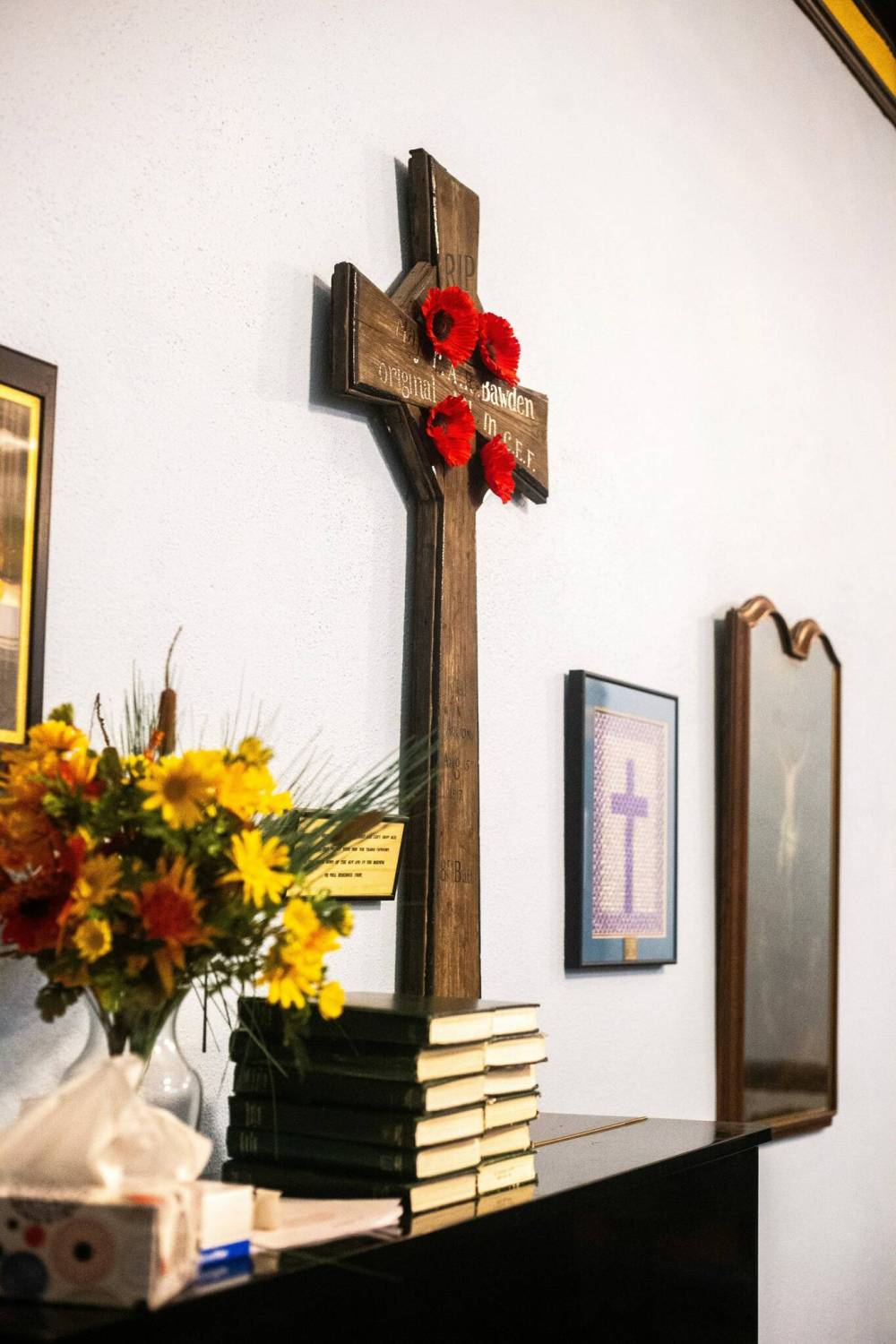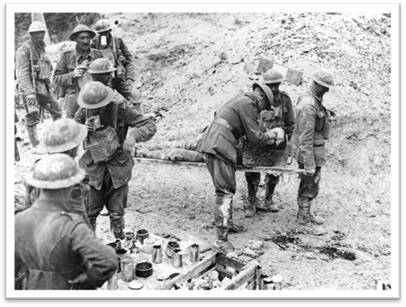Stark cross an apt memorial
Rough wooden crucifix, crafted from destroyed French church, honoured 90th Winnipeg Rifles major lost in suicidal First World War battle
Advertisement
Read this article for free:
or
Already have an account? Log in here »
To continue reading, please subscribe:
Monthly Digital Subscription
$0 for the first 4 weeks*
- Enjoy unlimited reading on winnipegfreepress.com
- Read the E-Edition, our digital replica newspaper
- Access News Break, our award-winning app
- Play interactive puzzles
*No charge for 4 weeks then price increases to the regular rate of $19.00 plus GST every four weeks. Offer available to new and qualified returning subscribers only. Cancel any time.
Monthly Digital Subscription
$4.75/week*
- Enjoy unlimited reading on winnipegfreepress.com
- Read the E-Edition, our digital replica newspaper
- Access News Break, our award-winning app
- Play interactive puzzles
*Billed as $19 plus GST every four weeks. Cancel any time.
To continue reading, please subscribe:
Add Free Press access to your Brandon Sun subscription for only an additional
$1 for the first 4 weeks*
*Your next subscription payment will increase by $1.00 and you will be charged $16.99 plus GST for four weeks. After four weeks, your payment will increase to $23.99 plus GST every four weeks.
Read unlimited articles for free today:
or
Already have an account? Log in here »
Hey there, time traveller!
This article was published 10/11/2023 (765 days ago), so information in it may no longer be current.
Plaques and memorials to men who died in the First World War were placed in many of Winnipeg’s older churches.

One such memorial — an old wooden cross — rests in the Lady Chapel at All Saints Anglican Church.
Under the headline Rude Wooden Cross Honors “No. 1, C.E.F.,” the Sept. 30, 1929 edition of the Winnipeg Free Press informed readers of an impressive ceremony attended by hundreds of men with the 90th Winnipeg Rifles that took place at the church.
The inscription on the darkly stained, starkly simple cross reads:
R.I.P. Major Alexander Bawden Original #1 m CEF Killed in Action 15 August 1917.
Men from the 8th Canadian Battalion (90th Winnipeg Rifles) had used wood from a destroyed French church to make grave markers for Bawden and the other men killed in the battalion’s suicidal Aug. 15, 1917, attack on Hill 70 near Lens, France.
When the Commonwealth War Graves Commission replaced them with standardized head stones, Bawden’s weather-worn cross was sent to the Winnipeg Rifles who repaired and reconditioned it.
Alexander Reginald Bawden was born in 1884 and raised in Cornwall, England. The family immigrated to Canada around 1907. Shortly after his arrival in Winnipeg, he joined the Rifles and rose through the ranks to became a senior non-commissioned officer.
He was working in railway construction in California when war was declared but rushed back to join his unit before it left for Valcartier Camp in Quebec where the Canadian Expeditionary Force was being formed. Either because of his rank or perhaps due to his rushing to the front of the line, Bawden was given the No. 1 regimental number when he attested in the CEF on Sept. 23, 1914.
The battalion embarked for England in October 1914 trained until February 1915 and went into the trenches a month later. In April 1915, the German army attacked and gassed the Canadian Division during the 2nd Battle of Ypres. Hundreds of men from the 8th Canadians were killed, wounded or taken prisoner.
Capt. George Watson, Bawden’s company commander, described Bawden as “one of the finest soldiers I ever met.” He received a battlefield commission for bravery during the battle. Bawden was severely wounded in the leg and upper body during the June 1915 Battle of Festubert.

While recuperating in England, Bawden married Lillian Drury, a Cornwall woman who was the same age as Bawden. Perhaps she was a childhood friend, a former sweetheart or just someone he met.
Bawden was declared fit for service back in Canada and was posted to train a new Winnipeg battalion. He returned to the 8th Canadians in October 1916, was promoted to major and fought with the battalion during the April 1917 Battle of Vimy Ridge. In July 1917, the Canadians were ordered to capture the city of Lens, France.
Gen. Arthur Currie’s plan was to take a high point known as Hill 70 before attacking the city. The preparations for the two-division attack assault were completed in August and the 8th battalion attacked on Aug. 15.
During their initial assault, the battalion advanced in the face of relentless heavy machine gun fire. It took its primary objective, but sustained too many casualties to advance any further. In the harsh calculus of the First World War, the assault was a success, but 150 men were killed and another 250 were wounded. The dead included Maj. Bawden.
Chaplain Capt. James Whillans wrote to Lillian in September to tell her how her husband had died. Whillans’ poignant letter, found in the Canadian War Museum Archives, reads:
Dear Mrs. Bawden,
I knew your husband very well… He drew the location of the position of his company on a map and told me to come up after the attack, marking the way for me. He was shot by a sniper in the shoulder when well up on the ground that had been captured from the enemy early in the morning.
I was at a camp kitchen when he was brought in by the stretcher bearers after having been dressed at a dressing station a little way up. I spoke to him but he had the appearance of being dead and did not move. A moment later a doctor pronounced him dead.
He was a friend of mine and I’m sorry to have to write this letter. He did his duty in a highly skilled manner and played his part in this Great War for human freedom.
May God bless you very abundantly in your loss.
In deepest sympathy,
James Whillans
Captain Chaplin
The moment where Whillans ministers to Bawden was captured by Canadian war photographer Lt. William Rider-Rider. It appeared the next day in Paris newspapers and later in publications around the world.
Lillian had followed her husband to Winnipeg in 1916 and lived on Fawcett Avenue in Wolseley. The inscription she asked to have carved on her husband’s permanent tombstone in Hersin Communal Cemetery in Pas de Calais, France, reads: Not Dead To Those Who Loved Him Only Gone Before. She never remarried, died in 1969 at age 83 and was interred in Brookside Cemetery in Winnipeg.
“Placing Bawden’s grave marker in All Saints Church is not only a reminder of his sacrifice, but also honours all who fell.”
There is little in Bawden’s personnel file to suggest he was much different from the tens of thousands of Manitoba’s soldiers who fought on the Western Front and the thousands buried in the mud of France and Flanders.
The 8th Canadian (90th Winnipeg Rifles) Battalion had more men killed in the First World War than any other Canadian battalion. Placing Bawden’s grave marker in All Saints Church is not only a reminder of his sacrifice, but also honours all who fell.
Ian Stewart is author of Seeing It Through: Manitoba’s Soldiers 1914-1919 and Holding Their Bit: Remembering the 8th Canadian Battalion (90th Winnipeg Rifles) 1914-1918. He visited Alexander Bawden’s grave in 2018.









